Alcohol
On this page, statistics are given for alcohol related behaviours, hospital activity and mortality.
Data for alcohol related behaviours include an estimate of the alcohol consumption patterns (e.g. percentage of those who abstain from alcohol, those who consume a lower risk amount, those who consume an increasing risk amount and those who consume a higher risk amount of alcohol) at Local Authority District level. Also included in the behaviours section is the rate of alcohol-related road traffic accidents (e.g. reported drink drive accidents) for each CCG in West Sussex.
Hospital activity, and mortality, are given at CCG level for conditions specific to alcohol and those related to alcohol:
- Alcohol-specific conditions: Conditions where alcohol is causally implicated in all cases of the condition. In this case the alcohol attributable fraction (the proportion of a health condition or external cause that is attributable to a specific risk factor in a given population) is 1.0, as all cases (100%) are caused by alcohol.
- Hospital-related conditions: All alcohol-specific conditions plus those where alcohol is causally implicated in some but not all causes of the outcome (e.g. hypertensive diseases, some cancers, and some cases of falls). The alcohol-attributable fraction will range from 0 to 1.0 according to the proportion of cases where the condition was caused by alcohol.
With the exception of modelled alcohol consumption estimates, all indicators are presented at CCG level.
Drinking behaviours
The North West Public Health Observatory (NWPHO) working with Liverpool John Moores University produced modelled estimates of drinking behaviour (among those aged 16 years and over) at Local Authority District level based on lifestyle survey data, hospital admissions, mortality data and population characteristics. Estimates for four groups were calculated: abstainers, lower risk drinkers, increasing risk drinkers and higher risk drinkers, aligned to national definitions.
Lower risk drinkers are defined as consumers of no more than 21 units per week for males and no more than 14 units per week for females. Increasing risk drinkers are defined as consumers of between 22 and 50 units of alcohol per week for males and between 15 and 35 units per week for females. Higher risk drinkers are consumers of above 50 units per week for males and more than 35 units per week for females.
The tables below show the modelled estimates of drinking behaviour for Crawley. The first table is an estimate of the whole population (including abstainers) and the second table is for drinkers only. In both tables, confidence intervals are very large and overlap. As such, the percentage estimates should be treated with caution.
Modelled drinking behaviours for Crawley; 2011
| Area | Abstain (95% CI) | Lower Risk (95% CI) | Increasing Risk (95% CI) | Higher Risk (95% CI) |
|---|---|---|---|---|
| Crawley | 11.5% (7.7-16.5%) | 62.1% (35.1-79%) | 22% (7.4-48.6%) | 4.3% (1.3-14.2%) |
| South East | 12.1% (7.3-18.1%) | 63.7% (36.7-80.3%) | 18.3% (5.7-44.1%) | 5.9% (1.8-18.8%) |
Modelled drinking behaviours - estimates for those who drink in Crawley; 2011
| Area | Abstain (95% CI) | Lower Risk (95% CI) | Increasing Risk (95% CI) | Higher Risk (95% CI) |
|---|---|---|---|---|
| Crawley | - (-) | 70.2% (39.7-87.3%) | 24.9% (8.2-54.4%) | 4.9% (1.5-16.3%) |
| South East | - (-) | 72.5% (41.7-91.3%) | 20.8% (6.4-50.1%) | 6.7% (2.0-21.4%) |
An alcohol related road accident is defined as a reported incident on a public road in which someone is killed or injured, where at least one of the motor vehicle drivers or riders involved either refused to give a breath test specimen when requested by the police (other than when incapable of doing so for medical reasons) or failed a roadside breath test by registering above 35 micrograms of alcohol per 100ml of breath. The statistic only includes incidents on public roads known to the police within 30 days of occurrence and so this is expected to be an underestimate of drink drinking behaviours. Data are pooled over three year periods to increase the accuracy of estimates.
In England, the rate per 1,000 for reported road accidents in which at least one driver failed a breath test has declined significantly between 2011-13 (27.6 accidents per 1,000 accidents, 95% CI: 27.1 – 28.2) and 2012-14 (26.4 accidents per 1,000 accidents, 25.8 – 26.9). In Crawley, the crude rate of alcohol related road accidents in 2012-14 was 29.3 alcohol related road accidents per 1,000 accidents (95% CI: 18.3 – 44.3 accidents), which is not significantly different from 2011-13 (35.6 accidents per 1,000, 95% CI: 23 – 52.6 accidents) or compared to the national rate.
The chart below shows the three year trend in alcohol related road traffic accidents in the three West Sussex CCGs between 2010-12 and 2012-14. As can be seen from the chart, there are large, overlapping confidence intervals at CCG level, indicating that there may be no difference across the CCGs.
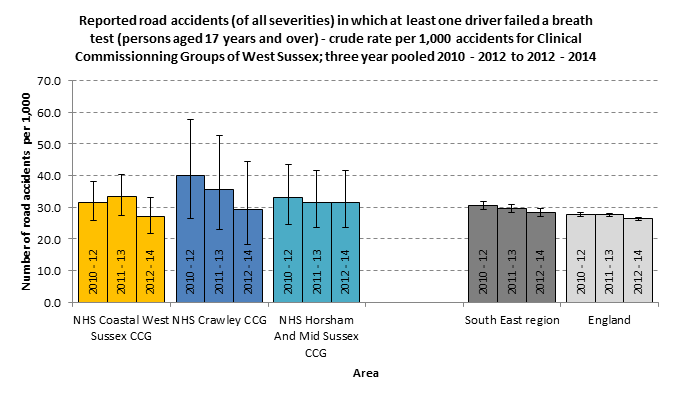
Alcohol related hospital activity
As part of the Local Alcohol Profiles for England, the Knowledge and Intelligence Team (North West) calculates the number of men and women admitted to hospital each year for alcohol-specific (conditions where alcohol is causally implicated in all cases of the condition) and alcohol-related conditions (alcohol-specific conditions plus those where alcohol is causally implicated in some but not all cases), yielding a period prevalence estimate of the number of persons admitted to hospital at least once during the course of a financial year. The analysis is carried out using data from the Health and Social Care Information Centre – Hospital Episode Statistics (HES) and Office for National Statistics (ONS) – Mid Year Population Estimates. There can be up to 20 diagnosis codes for a single episode, and one individual can have multiple episodes in a given year. As such, rules are used to avoid double counting of people for statistics which describe the number of people admitted to hospital for alcohol related conditions.
There are two definitions of alcohol-related hospital admissions used in the health profiles:
- Narrow definition: Persons admitted to hospital where the primary diagnosis is an alcohol-attributable code or one of the secondary codes is an external alcohol-attributable code.
- Broad definition: Persons admitted to hospital where the primary diagnosis or any of the secondary diagnoses are an alcohol-attributable code.
It should be noted that hospital admission data can be coded differently in different parts of the country. Moreover, in some cases, details of the patient’s residence are insufficient to allocate the patient to a particular area and in other cases the patient has no fixed abode. These cases are included in the England total but not in the smaller area (e.g. CCG level). Finally, some indicators are person based and others are admission based. For example, the number of people admitted to hospital due to alcohol-related conditions per 100,000 European Standard Population is a person-specific measure whilst the number of admission episodes for alcohol-related conditions per 100,000 European Standard Population is an admission-specific measure.
In NHS Crawley CCG in 2014/15, 285 people were admitted at least once to hospital for an alcohol-specific condition, at a rate of 282.4 people per 100,000 European Standard Population (ESP 2013) (95% CI: 249.7 – 318.1 people). This was similar to NHS Coastal West Sussex CCG (314.3 people admitted per 100,000 ESP 2013, 95% CI: 298.3 – 330.8 people), NHS Horsham and Mid Sussex CCG (229.8 people admitted per 100,000 ESP 2013, 95% CI: 210.2 – 250.8 people) and overall in the South East region for the same period (279.6 people admitted per 100,000, 95% CI: 276.1 – 283.2 people). However, the NHS Crawley CCG rate of people admitted for alcohol-specific conditions was significantly lower than the rate for England in the same period (364.4 people admitted per 100,000 ESP 2013, 95% CI: 362.8 – 366.1 people).
The chart below shows the annual trend data for West Sussex CCGs between 2010/11 and 2014/15 for persons admitted to hospital for alcohol-specific conditions. The chart indicates that there is an upward trend in NHS Crawley CCG in the first three years of the period, although differences may not be significant across individual years. However, there was a significant increase in the rate of alcohol-specific hospital admissions in the CCG between 2012/13 (278 people admitted per 100,000 ESP 2013, 95% CI: 245.4 – 313.7 people) and 2013/14 rate of 364.6 people (95% CI: 326.6 – 405.7) per 100,000 ESP 2013. However, in the most recent time period available (2014/15), the rate in NHS Crawley CCG (282.4 persons admitted per 100,000 ESP 2013, 95% CI: 249.7 – 318.1) was significantly lower compared to the previous year, indicating that data for 2013/14 may need to be explored further to identify reasons for the significant spike in admissions.
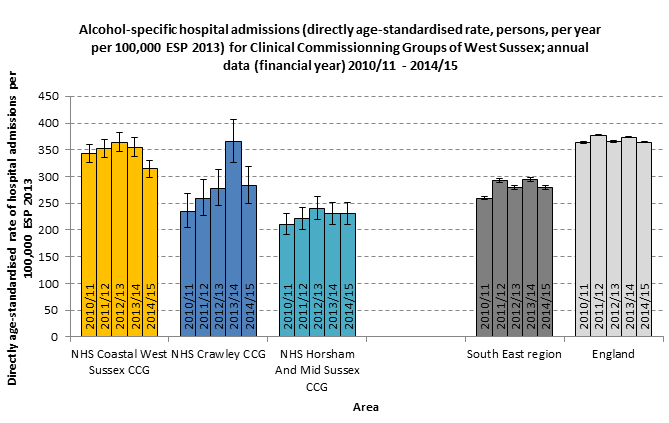
The number of people admitted to hospital for alcohol-specific conditions differs significantly among men and women, with men consistently having a higher rate of people admitted to hospital in all West Sussex CCGs, the South East region and in England in 2014/15 (see the chart below). In 2014/15, 180 men were admitted to hospital for an alcohol-specific condition in NHS Crawley CCG, at a rate of 367 people admitted per 100,000 ESP 2013 (95% CI: 313 – 427.5 people admitted). This is significantly higher than the female rate of admissions for NHS Crawley CCG in the same year (205.5 people admitted per 100,000 ESP 2013, 95% CI: 167.8 – 249 people, n= 110 people admitted).
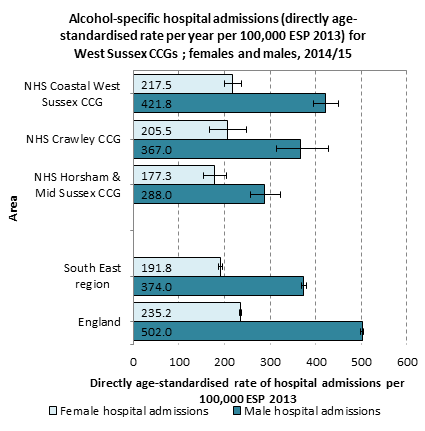
Admission Episodes
In 2014/15, there were 577 admission episodes for alcohol-related conditions (narrow definition) in NHS Crawley CCG. This represented 593.5 admissions per 100,000 ESP 2013 (95% CI: 544.5 – 645.6 admissions per 100,000 ESP 2013). The NHS Crawley CCG admission episodes rate was similar to NHS Coastal West Sussex CCG (592.4 admissions per 100,000 ESP 2013, 95% CI: 571 – 614.5 admissions) and the England rate overall (640.8 admissions per 100,000 ESP 2013, 638.6 – 643 admissions), but it was significantly higher than NHS Horsham and Mid Sussex CCG (468.1 admissions per 100,000 ESP 2013, 95% CI: 440 – 497.5 admissions). The chart below shows the trend in alcohol related (narrow definition) admissions per 100,000 ESP 2013 for years 2010/11 to 2014/15. As can be seen from the chart, although the admissions rate has increased in NHS Crawley CCG between 2010/11 and 2013/14 before declining in 2014/15, the overlapping confidence intervals suggest that there may be no significant difference across years.
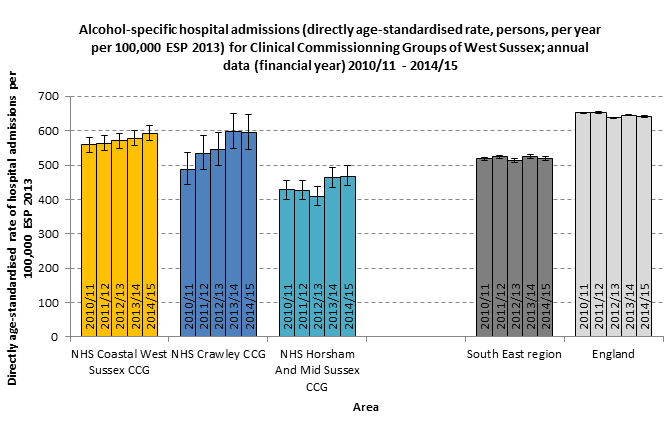
Hospital admissions episodes for alcohol related conditions by age.
Admission episode statistics for alcohol-related conditions are also broken down by age group. In 2014/15, more than one in four admission episodes in NHS Crawley CCG due to alcohol related conditions (narrow definition) were for those aged under 40 years (165 admission episodes, 25.4% of admission episodes, 95% CI: 25.1 – 32.5%). Almost half of admission episodes in 2014/15 in the CCG were to those aged 40-64 years (265 admission episodes, 45.9% of alcohol related admission episodes, 95% CI: 41.9 – 50%) and around one quarter of admission episodes were to those aged 65 years and over (25.4%, 95% CI: 22 – 29.1%).
There is a significant difference in the rate of admission episodes related to alcohol in NHS Crawley CCG in 2014/15 for those aged under 40 compared to 40-64 year olds and over 65s although there is no significant difference between the two older age groups (see chart below).
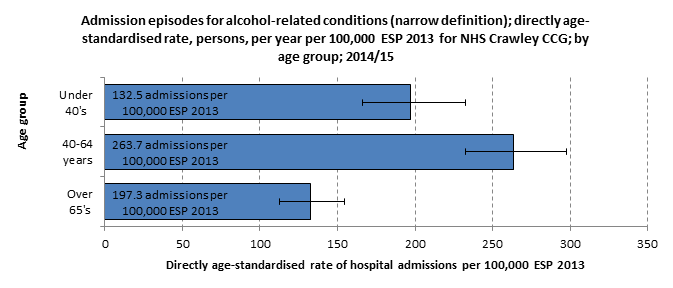
Among those aged under 40 years, the rate of admission episodes for alcohol related conditions (narrow definition) in NHS Crawley CCG, in 2014/15, was 132.5 admission episodes per 100,000 ESP 2013 (95% CI: 112.6 – 154.3 episodes). This is not significantly different to NHS Coastal West Sussex CCG (152 admission episodes per 100,000 ESP 2013, 95% CI: 140 – 164.8 episodes), NHS Horsham and Mid Sussex CCG (116 episodes per 100,000 ESP, 95% CI: 101.3 – 132) or England (150.6 episodes per 100,000 ESP 2013, 95% CI: 149.6 – 151.6). The chart below shows the five year annual trend for under 40s’ alcohol related hospital activity in West Sussex CCGs.
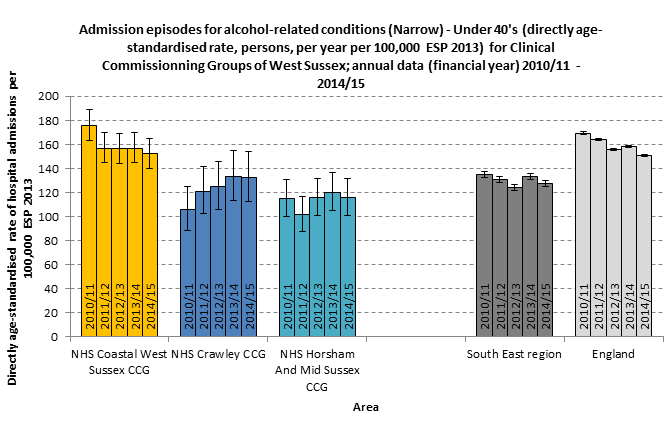
In NHS Crawley CCG, in 2014/15, the admission episode rate for under 40’s (see chart below) was not significantly higher among men (139.8 alcohol-related admission episodes per 100,000 ESP 2013, 95% CI: 114.4 – 172.4) compared to women (127.2 admission episodes per 100,000 ESP 2013, 95% CI: 99.9 – 158.8 episodes).
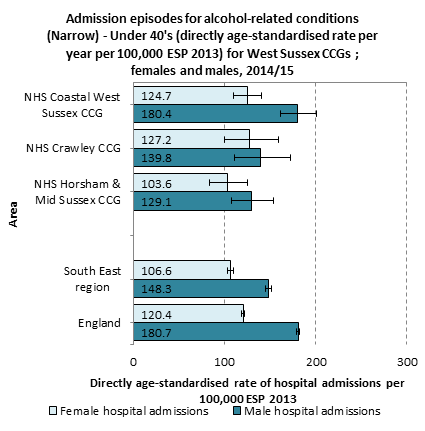
Among those aged 40-64 years, the rate of hospital admission episodes for alcohol-related conditions (narrow definition) was 263.7 admissions per 100,000 ESP 2013, 95% CI: 232.4 – 297.5) in NHS Crawley CCG in 2014/15. The NHS Crawley CCG rate is comparable to NHS Coastal West Sussex CCG (261 episodes per 100,000 ESP 2013, 95% CI: 246.8 – 275.8 episode) but significantly higher than NHS Horsham and Mid Sussex CCG (202.2 episodes per 100,000 ESP 2013, 95% CI: 184.5 – 221.1). The admission episode rate for 40-64 year olds in NHS Crawley CCG is significantly lower than the rate for England in 2014/15 (299.6 episodes per 100,000 ESP 2013, 95% CI: 298.1 – 301.1). The chart below shows the five year annual trend for alcohol related hospital activity in West Sussex CCGs among those aged 40-64 years.
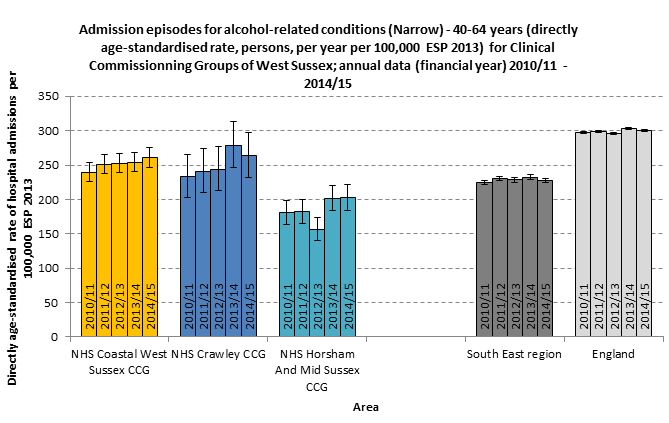
The hospital admissions for conditions related to alcohol (narrow definition) for those aged 40-64 years in 2014/15 was significantly higher among males (318.9 admissions per 100,000 ESP, 95% CI: 269.4 – 372.4 admissions) compared to females (210.6 admissions per 100,000 ESP 2013, 95% CI: 172.1 – 253.9) in the CCG. The chart below shows the hospital admission episode rate among men and women in West Sussex CCGs in 2014/15.
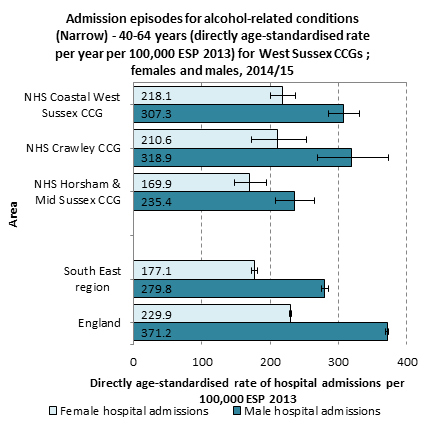
The rate of admissions in NHS Crawley CCG, in 2014/15, among those aged 65 years and over was 197.3 admissions per 100,000 ESP 2013 (95% CI: 166.1 – 232.5 admissions) and this is similar to the rate in NHS Coastal West Sussex CCG (179.4 admission episodes per 100,000 ESP 2013, 95% CI: 169.1 – 190.2) and for NHS Horsham and Mid Sussex CCG (149.9 admission episodes per 100,000 ESP 2013, 95% CI: 134 – 166.7). The NHS Crawley CCG rate is also similar to the rate for England in this period (190.5 admissions per 100,000 ESP 2013, 95% CI: 189.3 – 191.8). The chart below shows the five year trend in alcohol-related admissions (narrow definition) per 100,000 ESP 2013 for West Sussex CCGs between 2010/11 and 2014/15.
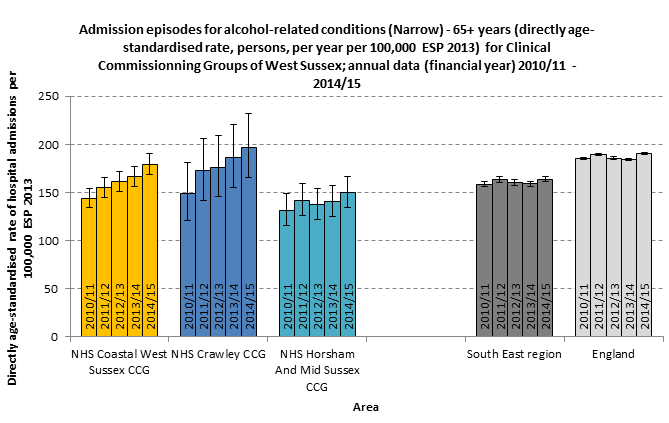
The rate of admission episodes among those aged 65 and over is significantly higher for men (287.2 admission episodes per 100,000 ESP 2013, 95% CI: 230.5 – 352.4) compared to women (126.6 admission episodes per 100,000 ESP 2013, 95% CI: 93.4 – 165.4) as shown in the chart below.
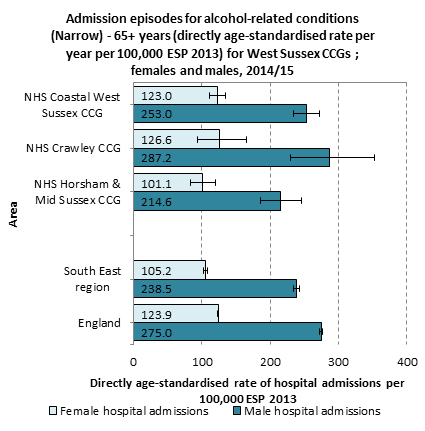
Alcohol related mortality
Alcohol-specific mortality (where alcohol is causally implicated in all cases of the condition or external cause of death) is based on three consecutive years of mortality data and is a directly age-standardised rate per year per 100,000 population (standardised to the European Standard Population, ESP 2013). In the period 2012-14, there were 25 alcohol-specific deaths in NHS Crawley CCG, representing a rate of 8.7 deaths per 100,000 ESP 2013 (95% CI: 5.6 – 12.9 deaths). This is statistically similar to the alcohol specific mortality rate in NHS Coastal West Sussex CCG (10 deaths per 100,000 ESP 2013, 95% CI: 8.4 – 11.7 deaths), NHS Horsham and Mid Sussex CCG (8 deaths per 100,000 ESP 2013, 95% CI: 6 – 10.4 deaths) and England (11.6 deaths per 100,000 ESP 2013, 95% CI 11.4 – 11.8 deaths). The large, overlapping, confidence intervals at CCG level shown in the five year trend chart below may be the product of the small number of deaths included at this level.
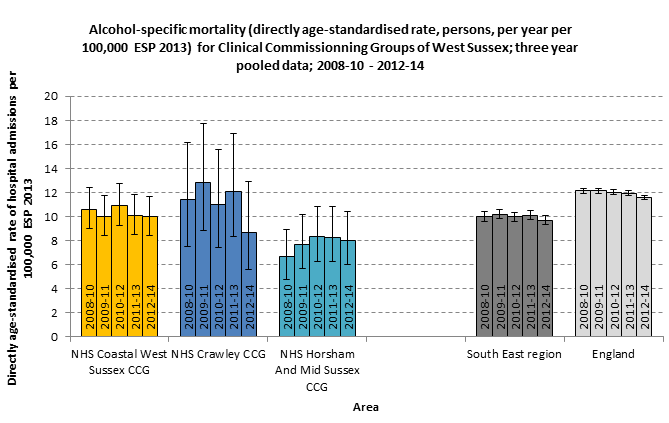
Data for alcohol-specific mortality are available at CCG level for men and women separately. This data indicates that in 2012-14, there were 15 alcohol-specific deaths among men in NHS Crawley CCG, at a rate of 11.6 deaths per 100,000 ESP 2013, 95% CI: 6.2 – 19.5 deaths). This is not significantly higher than the rate of alcohol-specific deaths among women in NHS Crawley CCG in 2012-14 (6.6 deaths per 100,000 ESP 2013, 95% CI: 3.1 – 12.1 deaths, based on 10 deaths). The statistical similarity may be the result of the small number of deaths in the Crawley area. The chart below shows the alcohol-specific mortality rate among men and women in West Sussex CCGs in 2012-14. This indicates that in the other West Sussex CCGs as well as regionally and nationally, men have a significantly higher alcohol-specific mortality rate than women.
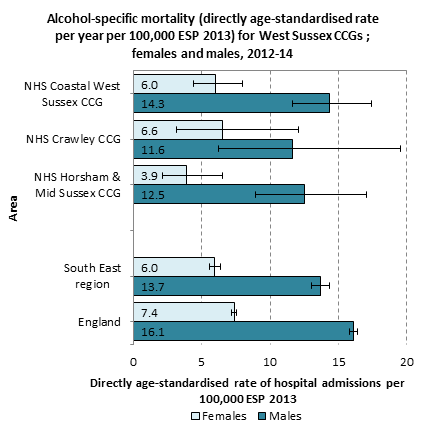
Months of life lost due to alcohol provide an estimate of the increase in life expectancy if all alcohol related deaths among those under 75 years were prevented. This data is available for lower and upper tier Local Authorities as well as CCGs and the latest data is available for the pooled period 2012-14. For men in England, in 2012-14, one year of life is lost on average due to alcohol-related conditions. In NHS Crawley CCG, 8 months of life are lost for men due to alcohol. The table below shows the months of life lost due to alcohol for males in West Sussex CCGs between 2008-10 and 2012-14. Confidence intervals are not available for these estimates.
The table shows that the months of life lost were lowest in NHS Crawley CCG compared to other CCGs in West Sussex, as well as West Sussex county in 2012-14 and in 2009-12, NHS Crawley CCG had the highest number of months lost due to alcohol for males compared to other CCGs.
Months of Life Lost due to alcohol; Males in West Sussex CCGs; 2008-10 to 2012-14
| Area | 2008-10 | 2009-11 | 2010-12 | 2011-13 | 2012-14 |
|---|---|---|---|---|---|
| NHS Coastal West Sussex CCG | 12.0 | 11.5 | 11.2 | 11.1 | 11.2 |
| NHS Crawley CCG | 11.3 | 12.4 | 11.0 | 9.9 | 8.0 |
| NHS Horsham And Mid Sussex CCG | 7.5 | 7.9 | 8.6 | 9.1 | 10.0 |
| West Sussex | 10.6 | 10.5 | 10.4 | 10.4 | 10.5 |
| South East region | 10.9 | 10.8 | 10.5 | 10.6 | 10.5 |
| England | 12.6 | 12.4 | 12.1 | 12.1 | 12.0 |
For women, on average 5.6 months of life was lost in England due to premature alcohol-related deaths for the period 2012-14. In NHS Crawley CCG, females lose on average 5.5 months of life due to alcohol. The table below shows the months of life lost due to alcohol for females in West Sussex CCGs between 2008-10 and 2012-14. With the exception of the first of the five periods of data, females in NHS Crawley CCG have lost more months, on average, compared to the other West Sussex CCGs.
Months of Life Lost due to alcohol; Females in West Sussex CCGs; 2008-10 to 2012-14
| Area | 2008-10 | 2009-11 | 2010-12 | 2011-13 | 2012-14 |
|---|---|---|---|---|---|
| NHS Coastal West Sussex CCG | 5.2 | 4.8 | 5.3 | 4.9 | 5.0 |
| NHS Crawley CCG | 5.0 | 6.3 | 6.8 | 7.1 | 5.5 |
| NHS Horsham And Mid Sussex CCG | 4.3 | 4.5 | 5.0 | 4.8 | 4.2 |
| West Sussex | 4.9 | 4.9 | 5.5 | 5.2 | 4.8 |
| South East region | 5.0 | 5.1 | 5.0 | 5.0 | 4.9 |
| England | 5.8 | 5.8 | 5.7 | 5.6 | 5.6 |